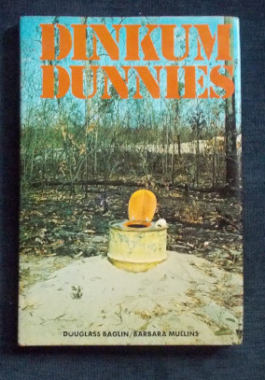-
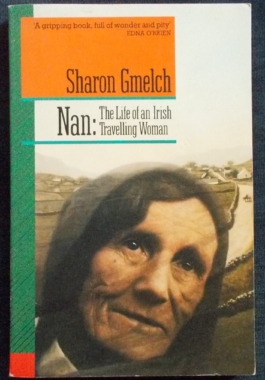 Nan Donohoe was an Irish Travelling woman, one of Ireland's indigenous gypsies or "tinkers." Traditionally, they traveled the countryside making and repairing tinware, sweeping chimneys, selling small household wares and doing odd-job work. Today, they live on the roadside in trailers and in government-built camps. Told largely in her own voice, Nan's saga begins in 1919 with her birth in a tent in the Irish Midlands; it follows her life in Ireland and England, in countryside and city slums, through adversity and adventure. Nan herself is seen as a person, not a subject. What emerges is a human story, filled with cruelty and compassion, sorrow and humor, bad luck and good. With black and white photographs.
Nan Donohoe was an Irish Travelling woman, one of Ireland's indigenous gypsies or "tinkers." Traditionally, they traveled the countryside making and repairing tinware, sweeping chimneys, selling small household wares and doing odd-job work. Today, they live on the roadside in trailers and in government-built camps. Told largely in her own voice, Nan's saga begins in 1919 with her birth in a tent in the Irish Midlands; it follows her life in Ireland and England, in countryside and city slums, through adversity and adventure. Nan herself is seen as a person, not a subject. What emerges is a human story, filled with cruelty and compassion, sorrow and humor, bad luck and good. With black and white photographs. -

Fatty: Andy Edmonds
$12.00Many people remember Roscoe Arbuckle as 'the fat comedian who raped that girl'. He was one of the highest paid actors of his day and Hollywood was at his feet. On September 5 1921 he threw a lavish party to celebrate his $3 million Paramount contract. It got wildly out of hand and ended abruptly when a starlet named Virginia Rappé let out a terrifying scream. Rappé died five days later and Arbuckle was charged with first-degree murder . Three trials later, he was finally acquitted - and by then his multi million dollar career was devastated and his life was ruined. Recreating the glittering Hollywood of the 1920s, Edmonds draws on new and hitherto unpublished evidence to determine what really happened on that fateful day. Illustrated with photographs. -

 A fascinating blend of Biblical commentary and travel narrative that characterised its predecessor, In The Steps Of The Master. Morton set himself the task of following the the Missionary Journeys of St. Paul and tracing the route by which Christianity came to the West. He made four journeys to the Near East, covering Palestine, Syria, Turkey, Macedonia, Greece, Cypress, Malta, Rhodes and the City of Rome. Morton wanted to portray St Paul as a Saint and a man, and what problems he would have encountered as he set out to Christianise the pagan world, to describe the world in which he lived and to contrast the cities of his day with their modern equivalents. Photographic illustrations.
A fascinating blend of Biblical commentary and travel narrative that characterised its predecessor, In The Steps Of The Master. Morton set himself the task of following the the Missionary Journeys of St. Paul and tracing the route by which Christianity came to the West. He made four journeys to the Near East, covering Palestine, Syria, Turkey, Macedonia, Greece, Cypress, Malta, Rhodes and the City of Rome. Morton wanted to portray St Paul as a Saint and a man, and what problems he would have encountered as he set out to Christianise the pagan world, to describe the world in which he lived and to contrast the cities of his day with their modern equivalents. Photographic illustrations. -
 Man has always sought answers for that which seems to be unanswerable - and there is so much in the world (and beyond) that is yet to be explored. How do some people 'know' the future with eerie accuracy? What is a coincidence? There are those who appear out of nowhere and those that vanish for ever...Are there monsters among us? Are miracles real? So much to learn...In this volume: Prophecies; Anomalies; Coincidences; Spontaneous Human Combustion; Inexplicable Crimes and Assaults; Appearances and Disappearances; Monsters; Spectral Incursions; Strange Things From Above; Unidentified Flying Objects; Atmospheric and Astronomical Oddities; Cures and Immunities; Signs and Wonders. With loads of fabulous black and white and colour photographs and illustrations.
Man has always sought answers for that which seems to be unanswerable - and there is so much in the world (and beyond) that is yet to be explored. How do some people 'know' the future with eerie accuracy? What is a coincidence? There are those who appear out of nowhere and those that vanish for ever...Are there monsters among us? Are miracles real? So much to learn...In this volume: Prophecies; Anomalies; Coincidences; Spontaneous Human Combustion; Inexplicable Crimes and Assaults; Appearances and Disappearances; Monsters; Spectral Incursions; Strange Things From Above; Unidentified Flying Objects; Atmospheric and Astronomical Oddities; Cures and Immunities; Signs and Wonders. With loads of fabulous black and white and colour photographs and illustrations. -

The Great Fletch: Hugh Lunn
$30.00When a passing French tennis superstar gave the young Ken Fletcher his tennis racquet, he didn't know what he'd started. Ken, a lonely only child with an irrepressible spirit, took the racquet, which was far too too big for him, tucked its handle under his armpit and began to bang the ball against a board in this back garden, using his whole body to get behind the ball. The result was a perfect, stunning forehand. Annersley Junction was more than a bit surprised when young Ken was seeded Number 3 at Wimbledon and won a Grand Slam with that forehand, used to devastating effect. Ken went on to lead a life of dazzling glamour: casinos,chauffeur-driven cars, beautiful women and applauding crowds. Hugh Lunn explores how a boy from Annesley Junction turned into a champion tennis player, and with his trademark humour and style he not only brings us the life of a sporting great, he describes a picture of a more innocent time in Australian history. -
 The story of four young men from the wrong side of the tracks in New Jersey who came together to form the iconic group Frankie Valli and the Four Seasons. Their trials and triumphs are accompanied by the hit songs that influenced a generation: Sherry, Big Girls Don't Cry, Walk Like A Man, Dawn, Rag Doll, Bye Bye Baby and more. Also stars Michael Lomenda, Vincent Piazza and Christopher Walken.
The story of four young men from the wrong side of the tracks in New Jersey who came together to form the iconic group Frankie Valli and the Four Seasons. Their trials and triumphs are accompanied by the hit songs that influenced a generation: Sherry, Big Girls Don't Cry, Walk Like A Man, Dawn, Rag Doll, Bye Bye Baby and more. Also stars Michael Lomenda, Vincent Piazza and Christopher Walken. -
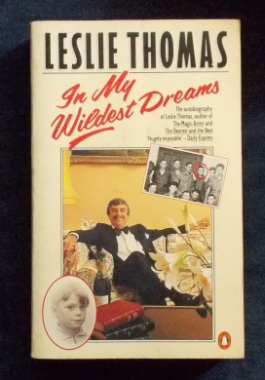 From Barnardo boy to original virgin soldier; from apprentice journalist in London's Fleet Street to famous novelist...At times funny, at times sad, but always honest and utterly compulsive, Leslie Thomas's story is straight out of fiction. As an orphan, he picked his way through the rubble of post-war Britain and was sent on national service to the Far East. Later he became a Fleet Street reporter, with hilarious experiences to relate, and then became the bestselling author of The Virgin Soldiers - the novel that, although scandalous in its day, is now recognised as a classic of its kind. He is also the creator of Dangerous The Last Detective, which has been adapted into a popular television series. In 2005, Leslie Thomas was awarded an OBE for services to literature.
From Barnardo boy to original virgin soldier; from apprentice journalist in London's Fleet Street to famous novelist...At times funny, at times sad, but always honest and utterly compulsive, Leslie Thomas's story is straight out of fiction. As an orphan, he picked his way through the rubble of post-war Britain and was sent on national service to the Far East. Later he became a Fleet Street reporter, with hilarious experiences to relate, and then became the bestselling author of The Virgin Soldiers - the novel that, although scandalous in its day, is now recognised as a classic of its kind. He is also the creator of Dangerous The Last Detective, which has been adapted into a popular television series. In 2005, Leslie Thomas was awarded an OBE for services to literature. -
 Like the Beaumont children and the Azaria Chamberlain cases before it, the backpacker murder case in Belanglo State Forest has entered Australian criminal folklore. Seven young people, most of them foreigners backpacking around Australia, brutally murdered, their remains uncovered in 1992 and 1993. It would take scores of police over three years, countless hours of forensic investigation, thousands of false leads and a few precious clues to charge and convict Ivan Milat for their horrific deaths. This is the definitive work on Ivan Milat, his family and the murders. Almost four years in the making, informed by exclusive interviews with members of the Milat family, key police investigators and Crown lawyers, this book reveals a family culture so bizarre it would lead inexorably to murder. It also scrutinises the police investigation – its remarkable success and failures, the dramatic turning point and the backbiting and bitterness that followed Milat's arrest. Thought-provoking, totally unsalacious and an exploration of the darker side of Australian life as a whole. Photographic illustrations.
Like the Beaumont children and the Azaria Chamberlain cases before it, the backpacker murder case in Belanglo State Forest has entered Australian criminal folklore. Seven young people, most of them foreigners backpacking around Australia, brutally murdered, their remains uncovered in 1992 and 1993. It would take scores of police over three years, countless hours of forensic investigation, thousands of false leads and a few precious clues to charge and convict Ivan Milat for their horrific deaths. This is the definitive work on Ivan Milat, his family and the murders. Almost four years in the making, informed by exclusive interviews with members of the Milat family, key police investigators and Crown lawyers, this book reveals a family culture so bizarre it would lead inexorably to murder. It also scrutinises the police investigation – its remarkable success and failures, the dramatic turning point and the backbiting and bitterness that followed Milat's arrest. Thought-provoking, totally unsalacious and an exploration of the darker side of Australian life as a whole. Photographic illustrations. -
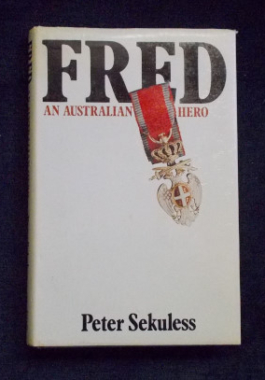 Toward the end of 1977, articles appeared in Australian newspapers about a remarkable 97 year-old Australian who had just died in Khartoum. They told of an heroic figure who had been with General Freyberg, then a junior officer, when he made his daring Dardenelles swim before the landing at Gallipoli; who had been mentioned in dispatches at the Battle of Beersheba; who had been with Lawrence of Arabia and who had won several decorations, including the George Cross for bravery under fire when he was chauffeur to the Governor-General of the Sudan at the time of his assassination in Cairo in 1924. He was one of the few Australians ever to win the coveted Serbian Eagle. This incredible Australian was Frederick Hamilton March. The newspaper articles so intrigued Sekuless than he began keeping a file on Fred March. Eventually, he travelled to Khartoum, Cairo, Gallipoli and London in a quest for information about this elusive and unknown Aussie hero to piece together the fascinating story of Fred March. Illustrated with black and white archival photographs.
Toward the end of 1977, articles appeared in Australian newspapers about a remarkable 97 year-old Australian who had just died in Khartoum. They told of an heroic figure who had been with General Freyberg, then a junior officer, when he made his daring Dardenelles swim before the landing at Gallipoli; who had been mentioned in dispatches at the Battle of Beersheba; who had been with Lawrence of Arabia and who had won several decorations, including the George Cross for bravery under fire when he was chauffeur to the Governor-General of the Sudan at the time of his assassination in Cairo in 1924. He was one of the few Australians ever to win the coveted Serbian Eagle. This incredible Australian was Frederick Hamilton March. The newspaper articles so intrigued Sekuless than he began keeping a file on Fred March. Eventually, he travelled to Khartoum, Cairo, Gallipoli and London in a quest for information about this elusive and unknown Aussie hero to piece together the fascinating story of Fred March. Illustrated with black and white archival photographs. -
 At the heart of this wonderful biography is the relationship between two great American women whose lives were bound together for all time: Annie Sullivan and Helen Keller. Lash follows this gifted, passionate and humanly flawed pair for 100 years, from Annie's childhood in an almshouse in the 1860s, through decades of international fame, to Helen's death in 1968. Among the vivid characters associated with their lives are Alexander Graham Bell, Mark Twain, Andrew Carnegie, Charlie Chaplin, and Eleanor and Franklin Roosevelt. Illustrated with black and white photographs.
At the heart of this wonderful biography is the relationship between two great American women whose lives were bound together for all time: Annie Sullivan and Helen Keller. Lash follows this gifted, passionate and humanly flawed pair for 100 years, from Annie's childhood in an almshouse in the 1860s, through decades of international fame, to Helen's death in 1968. Among the vivid characters associated with their lives are Alexander Graham Bell, Mark Twain, Andrew Carnegie, Charlie Chaplin, and Eleanor and Franklin Roosevelt. Illustrated with black and white photographs. -
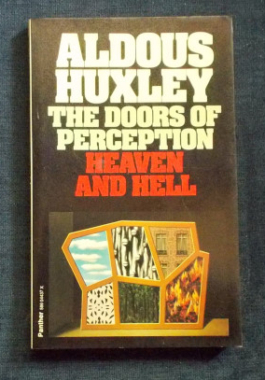 Huxley first took mescaline in 1953 and continued his experiments with hallucinogenic drugs until 1963 when - on his deathbed - he asked for and was given LSD. In these short but intensely illuminating essays, he explores the effects of the mescaline experience, describing how the drug enabled him to discover a 'sacramental vision of reality'. He also discusses the spiritual and moral implications of the experience, demonstrating how negative emotions can transform man's perceptual Nirvana into a 'schizophrenic hell'.
Huxley first took mescaline in 1953 and continued his experiments with hallucinogenic drugs until 1963 when - on his deathbed - he asked for and was given LSD. In these short but intensely illuminating essays, he explores the effects of the mescaline experience, describing how the drug enabled him to discover a 'sacramental vision of reality'. He also discusses the spiritual and moral implications of the experience, demonstrating how negative emotions can transform man's perceptual Nirvana into a 'schizophrenic hell'. -
 Stories and yarns of racetrack, trials, pioneer, veteran, vintage and outback motoring in Australia and New Zealand. Contributors include: Peter Antill (The Emus Were Scary); Nino Culotta (By Taxi to King's Bloody Cross); Bruce McClaren (A Racing Driver's Story) and the Australian Automobile Clubs ( Australian Cars Go To War!);Barry Crump (Does Your Speedo Work?) among many others.
Stories and yarns of racetrack, trials, pioneer, veteran, vintage and outback motoring in Australia and New Zealand. Contributors include: Peter Antill (The Emus Were Scary); Nino Culotta (By Taxi to King's Bloody Cross); Bruce McClaren (A Racing Driver's Story) and the Australian Automobile Clubs ( Australian Cars Go To War!);Barry Crump (Does Your Speedo Work?) among many others. -
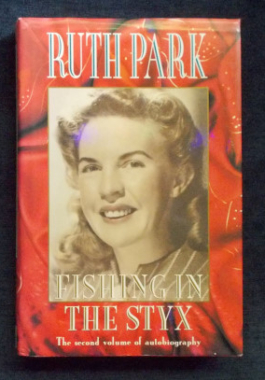 Born in New Zealand, Ruth Park came to Australia to continue her work as a journalist, newly married to D'Arcy Niland. Determined to earn their living as writers, they submitted story outlines to radio stations, idea for articles to newspapers and accepted whatever freelance jobs came their way. The Harp in the South, Park’s first novel, was published in 1948 and set her on the path to becoming one of Australia’s most loved authors. Fishing in the Styx is the second part of her autobiography and is the portrait of a partnership, in life and in work, between two talented, volatile people. Ruth Park’s life is rich in experience and achievement, and her work has given pleasure to generations of readers. Illustrated. https://cosmiccauldronbooks.com.au/p/fence-around-cuckoo-ruth-park/
Born in New Zealand, Ruth Park came to Australia to continue her work as a journalist, newly married to D'Arcy Niland. Determined to earn their living as writers, they submitted story outlines to radio stations, idea for articles to newspapers and accepted whatever freelance jobs came their way. The Harp in the South, Park’s first novel, was published in 1948 and set her on the path to becoming one of Australia’s most loved authors. Fishing in the Styx is the second part of her autobiography and is the portrait of a partnership, in life and in work, between two talented, volatile people. Ruth Park’s life is rich in experience and achievement, and her work has given pleasure to generations of readers. Illustrated. https://cosmiccauldronbooks.com.au/p/fence-around-cuckoo-ruth-park/ -
 The Honey Badger (Mellivora capensis) also known as Nick Cummins (Cummo or Nick) is a species of rugby player native to Queensland, Port Macquarie and Perth. Despite its size, the honey badger does not closely resemble other wingers; instead, it bears more anatomical similarities to a forward. It is well known for its extensive range of puns, analogies, mischief and general ability to adapt to any environment. It is primarily carnivorous - beef is its preference - and has few natural predators because of its thick skin, self-deprecating sense of humour and ferocious defensive abilities. Nick Cummins is writing his opus, his tome - his first book. Packed with Nick's sensational sayings, ripper yarns and pure Aussie wisdom, it's a charming collection of short stories celebrating the importance of family, mates, rugby and getting out amongst it (i.e. seeing the world). Illustrated with colour photographs.
The Honey Badger (Mellivora capensis) also known as Nick Cummins (Cummo or Nick) is a species of rugby player native to Queensland, Port Macquarie and Perth. Despite its size, the honey badger does not closely resemble other wingers; instead, it bears more anatomical similarities to a forward. It is well known for its extensive range of puns, analogies, mischief and general ability to adapt to any environment. It is primarily carnivorous - beef is its preference - and has few natural predators because of its thick skin, self-deprecating sense of humour and ferocious defensive abilities. Nick Cummins is writing his opus, his tome - his first book. Packed with Nick's sensational sayings, ripper yarns and pure Aussie wisdom, it's a charming collection of short stories celebrating the importance of family, mates, rugby and getting out amongst it (i.e. seeing the world). Illustrated with colour photographs. -
 Here are the stories behind Australia's many, many strange, inappropriate and downright hilarious place names. From Dismal Swamp to Useless Loop, Intercourse Island to Dead Mans Gully, Mount Buggery to Nowhere Else, Australia has some of the strangest, funniest, weirdest and most out-of-place names going - now described and explained in one humorous and fascinating book. Australia's vast spaces and irreverent, larrikin history have given us some of the best place names in the world. Ranging from the less than positive (Linger and Die Hill, NSW), to the indelicate (Scented Knob, WA), the idiotic (Eggs and Bacon Bay, TAS) to the inappropriate and the just plain fascinating, this is a toponymical journey through this nation of weird and wonderful places.
Here are the stories behind Australia's many, many strange, inappropriate and downright hilarious place names. From Dismal Swamp to Useless Loop, Intercourse Island to Dead Mans Gully, Mount Buggery to Nowhere Else, Australia has some of the strangest, funniest, weirdest and most out-of-place names going - now described and explained in one humorous and fascinating book. Australia's vast spaces and irreverent, larrikin history have given us some of the best place names in the world. Ranging from the less than positive (Linger and Die Hill, NSW), to the indelicate (Scented Knob, WA), the idiotic (Eggs and Bacon Bay, TAS) to the inappropriate and the just plain fascinating, this is a toponymical journey through this nation of weird and wonderful places. -
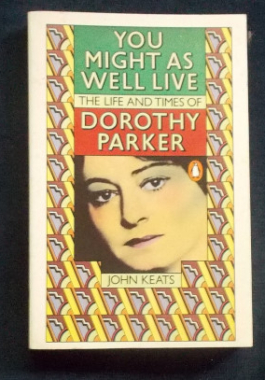 'How could they tell?' inquired Dorothy Parker when it was announced that president Coolidge had died. Her serpent tongue was notorious in the age of F. Scott Fitzgerald and Hemingway. gay, attractive, crackling with talent, Dorothy Parker starred in the most famous literary circle of the day. In verse, in New Yorker reviews, in lightning wisecracks, she cut everyone down to her own five feet. This is a recapturing of the extraordinary woman who lived and drank in splendour, loved in snatches, practised suicide and died alone in squalor. Beyond the wit abd glitter, the story is sad yet brave.
'How could they tell?' inquired Dorothy Parker when it was announced that president Coolidge had died. Her serpent tongue was notorious in the age of F. Scott Fitzgerald and Hemingway. gay, attractive, crackling with talent, Dorothy Parker starred in the most famous literary circle of the day. In verse, in New Yorker reviews, in lightning wisecracks, she cut everyone down to her own five feet. This is a recapturing of the extraordinary woman who lived and drank in splendour, loved in snatches, practised suicide and died alone in squalor. Beyond the wit abd glitter, the story is sad yet brave. -
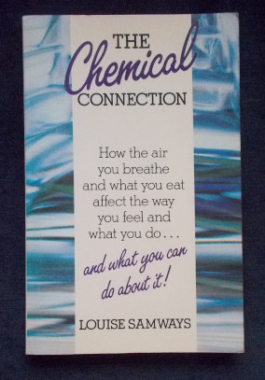 Do you feel 'spaced out' after using strong household cleaners or a photocopier? Do you feel sick while having your car filled up with petrol or do you love the smell and can't get enough of it? Do you get headaches or ache all over after a day in the city? Since World War Two, our bodies have been assaulted by a barrage of previously unknown physical hazards — thousands of new chemicals in our air, water and food; electromagnetic radiation and changes in ultra-violet light conditions. This book explains how chemical sensitivities can have a profound and alarming effect on our social, emotional and intellectual development. It also discusses what we can do about it. The book offers a range of sensible and practical precautions we can take to minimize our chemical exposure, and encourages us to choose the least chemically hazardous options — or demand that satisfactory alternatives be made available.
Do you feel 'spaced out' after using strong household cleaners or a photocopier? Do you feel sick while having your car filled up with petrol or do you love the smell and can't get enough of it? Do you get headaches or ache all over after a day in the city? Since World War Two, our bodies have been assaulted by a barrage of previously unknown physical hazards — thousands of new chemicals in our air, water and food; electromagnetic radiation and changes in ultra-violet light conditions. This book explains how chemical sensitivities can have a profound and alarming effect on our social, emotional and intellectual development. It also discusses what we can do about it. The book offers a range of sensible and practical precautions we can take to minimize our chemical exposure, and encourages us to choose the least chemically hazardous options — or demand that satisfactory alternatives be made available. -
 Over 1000 hints and recipes for making your own wine and beers - an enjoyable hobby you can share with friends and make great savings in costs, too. There's sections on country wines, fruit wines, sparkling wines, malt syrup beers, fruit beers, ciders, liqueurs and even flavoured vinegars for cooking. All the information is here - ingredients, equipment and step by step instructions.
Over 1000 hints and recipes for making your own wine and beers - an enjoyable hobby you can share with friends and make great savings in costs, too. There's sections on country wines, fruit wines, sparkling wines, malt syrup beers, fruit beers, ciders, liqueurs and even flavoured vinegars for cooking. All the information is here - ingredients, equipment and step by step instructions. -

 Three volumes in one: The Heart Of London: A collection of newspaper stories he wrote for The Daily Express on his return to Fleet Street from service with the Warwickshire Yeomanry in World War I. Morton investigates Petticoat Lane; the Caledonian market; the free cancer hospital; watches faces in The Strand; the Westminster Abbey waxworks and much more. The Spell Of London: anecdotes from his daily trawls of London, packed with humour and charm combined with acute observation, sympathy and an engaging curiosity. He investigates the Tower of London, Big Ben, Leather Lane Street Market; The Children's Ward ; The Notting Hill Rag Fair and more. The Nights Of London: Anecdotes from his nightly trawls of London with acute observations of the night life he observes; when the 'Tubes' stop; ships at sight; Waterloo Bridge; stage doors; a night in hospital; Fan-Tan; pub crawlers; night clubs and more.
Three volumes in one: The Heart Of London: A collection of newspaper stories he wrote for The Daily Express on his return to Fleet Street from service with the Warwickshire Yeomanry in World War I. Morton investigates Petticoat Lane; the Caledonian market; the free cancer hospital; watches faces in The Strand; the Westminster Abbey waxworks and much more. The Spell Of London: anecdotes from his daily trawls of London, packed with humour and charm combined with acute observation, sympathy and an engaging curiosity. He investigates the Tower of London, Big Ben, Leather Lane Street Market; The Children's Ward ; The Notting Hill Rag Fair and more. The Nights Of London: Anecdotes from his nightly trawls of London with acute observations of the night life he observes; when the 'Tubes' stop; ships at sight; Waterloo Bridge; stage doors; a night in hospital; Fan-Tan; pub crawlers; night clubs and more. -
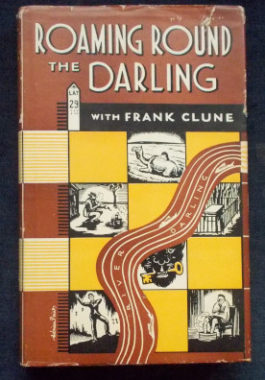 Gundabooka, Milparinka, Tibooburra, Innamincka...just some of the places on Clune's path when he set out from Sydney on a 2000 mile tour of Western New South Wales and beyond, treading the paths of the pioneers and experiencing the beauty as well as the toughness of the land. He finds something of interest in every town and settlement, stories and anecdotes and odd and fascinating details of history. Illustrated with black and white photographs.
Gundabooka, Milparinka, Tibooburra, Innamincka...just some of the places on Clune's path when he set out from Sydney on a 2000 mile tour of Western New South Wales and beyond, treading the paths of the pioneers and experiencing the beauty as well as the toughness of the land. He finds something of interest in every town and settlement, stories and anecdotes and odd and fascinating details of history. Illustrated with black and white photographs. -
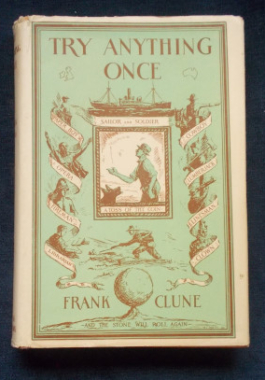 Clune's first book - his autobiography beginning with leaving home at 15 and ending with his marriage and a family. In between...he traveled the world, often crewing on ships, travelled around Australia and was been fired or quit from more jobs than most people have hot dinners. Clune, like all lovable rogues, finds himself in all sorts of strife - mostly of his own making, whether it be applying for the United States cavalry to enlisting with the Australian Army and serving in Gallipoli; he also worked as a salesman, butcher, paper boy, lumberjack, clown, opera...
Clune's first book - his autobiography beginning with leaving home at 15 and ending with his marriage and a family. In between...he traveled the world, often crewing on ships, travelled around Australia and was been fired or quit from more jobs than most people have hot dinners. Clune, like all lovable rogues, finds himself in all sorts of strife - mostly of his own making, whether it be applying for the United States cavalry to enlisting with the Australian Army and serving in Gallipoli; he also worked as a salesman, butcher, paper boy, lumberjack, clown, opera... -
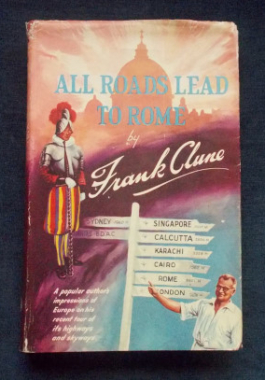 With his usual skill, Frank Clune weaves history and contemporary fact into an exciting and significant pattern that will delight armchair travellers who accompany him on this unusual tour through Italy, Switzerland, Germany, Denmark, Austria and Greece, by plane, train and jeep. The primary reason for Clune's journey was to learn something about the work of the International Refugee Organisation, to see the migrant camps and to see displaced persons go through the initial stages that prepared them to become new Australians and listens to their hopes and dreams of Australia. With black and white photographs.
With his usual skill, Frank Clune weaves history and contemporary fact into an exciting and significant pattern that will delight armchair travellers who accompany him on this unusual tour through Italy, Switzerland, Germany, Denmark, Austria and Greece, by plane, train and jeep. The primary reason for Clune's journey was to learn something about the work of the International Refugee Organisation, to see the migrant camps and to see displaced persons go through the initial stages that prepared them to become new Australians and listens to their hopes and dreams of Australia. With black and white photographs. -

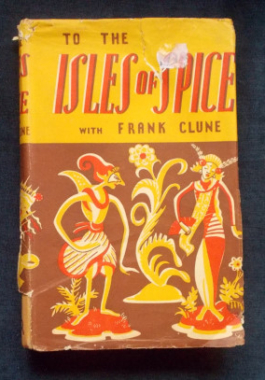 Frank visits an opium den; watches the preparations of the betel-nut for chewing and then tries some; visits the aeroplane experiment station at Bandoeng and makes a trip to the stratosphere (fainting before 30,000 feet...)' attends a chief's funeral in the Celebes - and makes a quite unintentional contribution to the ceremonial that upsets the gravity of all. Illustrated with black and white photographs.
Frank visits an opium den; watches the preparations of the betel-nut for chewing and then tries some; visits the aeroplane experiment station at Bandoeng and makes a trip to the stratosphere (fainting before 30,000 feet...)' attends a chief's funeral in the Celebes - and makes a quite unintentional contribution to the ceremonial that upsets the gravity of all. Illustrated with black and white photographs. -
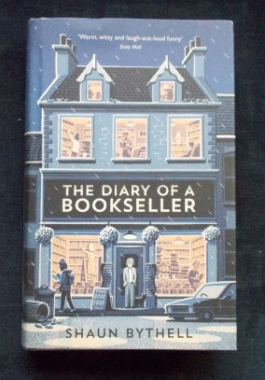 Shaun Bythell owns The Bookshop, Wigtown - Scotland's largest second-hand bookshop. It contains 100,000 books, spread over a mile of shelving, with twisting corridors and roaring fires, and all set in a beautiful, rural town by the edge of the sea. A book-lover's paradise? Well, almost ... In these wry and hilarious diaries, Shaun provides an inside look at the trials and tribulations of life in the book trade, from struggles with eccentric customers to wrangles with his own staff, who include the ski-suit-wearing, bin-foraging Nicky. He takes us with him on buying trips to old estates and auction houses, recommends books (both lost classics and new discoveries), introduces us to the thrill of the unexpected find and evokes the rhythms and charms of small-town life, always with a sharp and sympathetic eye.
Shaun Bythell owns The Bookshop, Wigtown - Scotland's largest second-hand bookshop. It contains 100,000 books, spread over a mile of shelving, with twisting corridors and roaring fires, and all set in a beautiful, rural town by the edge of the sea. A book-lover's paradise? Well, almost ... In these wry and hilarious diaries, Shaun provides an inside look at the trials and tribulations of life in the book trade, from struggles with eccentric customers to wrangles with his own staff, who include the ski-suit-wearing, bin-foraging Nicky. He takes us with him on buying trips to old estates and auction houses, recommends books (both lost classics and new discoveries), introduces us to the thrill of the unexpected find and evokes the rhythms and charms of small-town life, always with a sharp and sympathetic eye. -

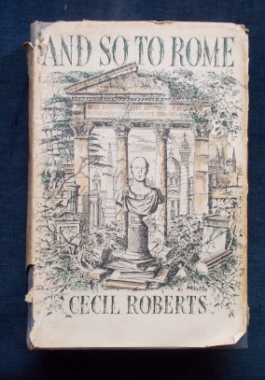 Roberts; survey of 2000 years in the life of the greatest city in history is a pageant with frequent excursions into the trivia of ancient scandals and the excesses of papal and other tyrants.He takes a famous Roman castle, villa or ruin and recalls to its battlements, boudoirs or colonnades its most celebrated - or notorious - occupants. Or he looks upon a masterpiece of painting or sculpture and can tell a long tale with gossipy tidbits. He also muses - and presents observations - on the way in which Rome presents an "astonishing graph" of the rise and fall of the Roman people Fine illustrations and photographs.
Roberts; survey of 2000 years in the life of the greatest city in history is a pageant with frequent excursions into the trivia of ancient scandals and the excesses of papal and other tyrants.He takes a famous Roman castle, villa or ruin and recalls to its battlements, boudoirs or colonnades its most celebrated - or notorious - occupants. Or he looks upon a masterpiece of painting or sculpture and can tell a long tale with gossipy tidbits. He also muses - and presents observations - on the way in which Rome presents an "astonishing graph" of the rise and fall of the Roman people Fine illustrations and photographs.




